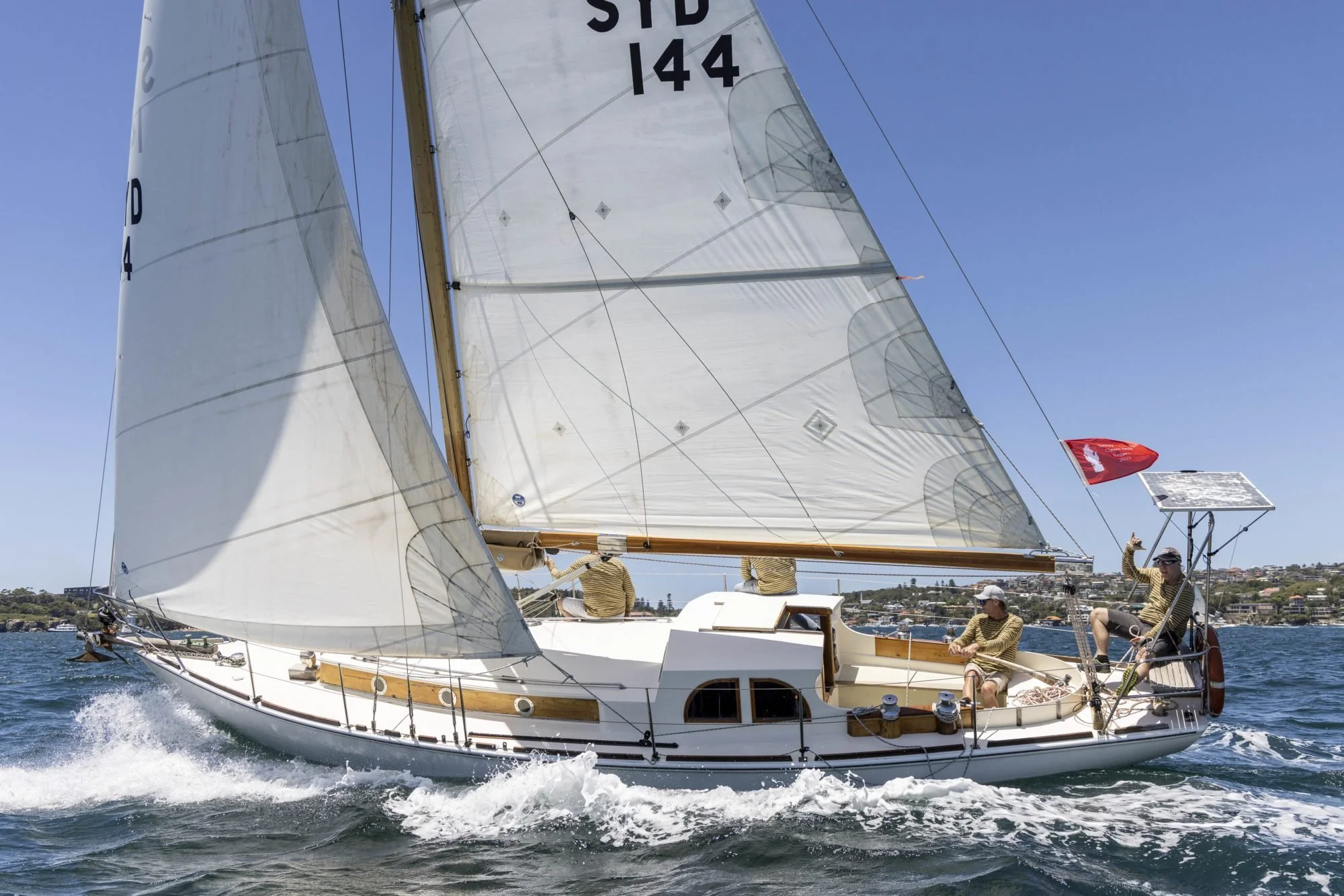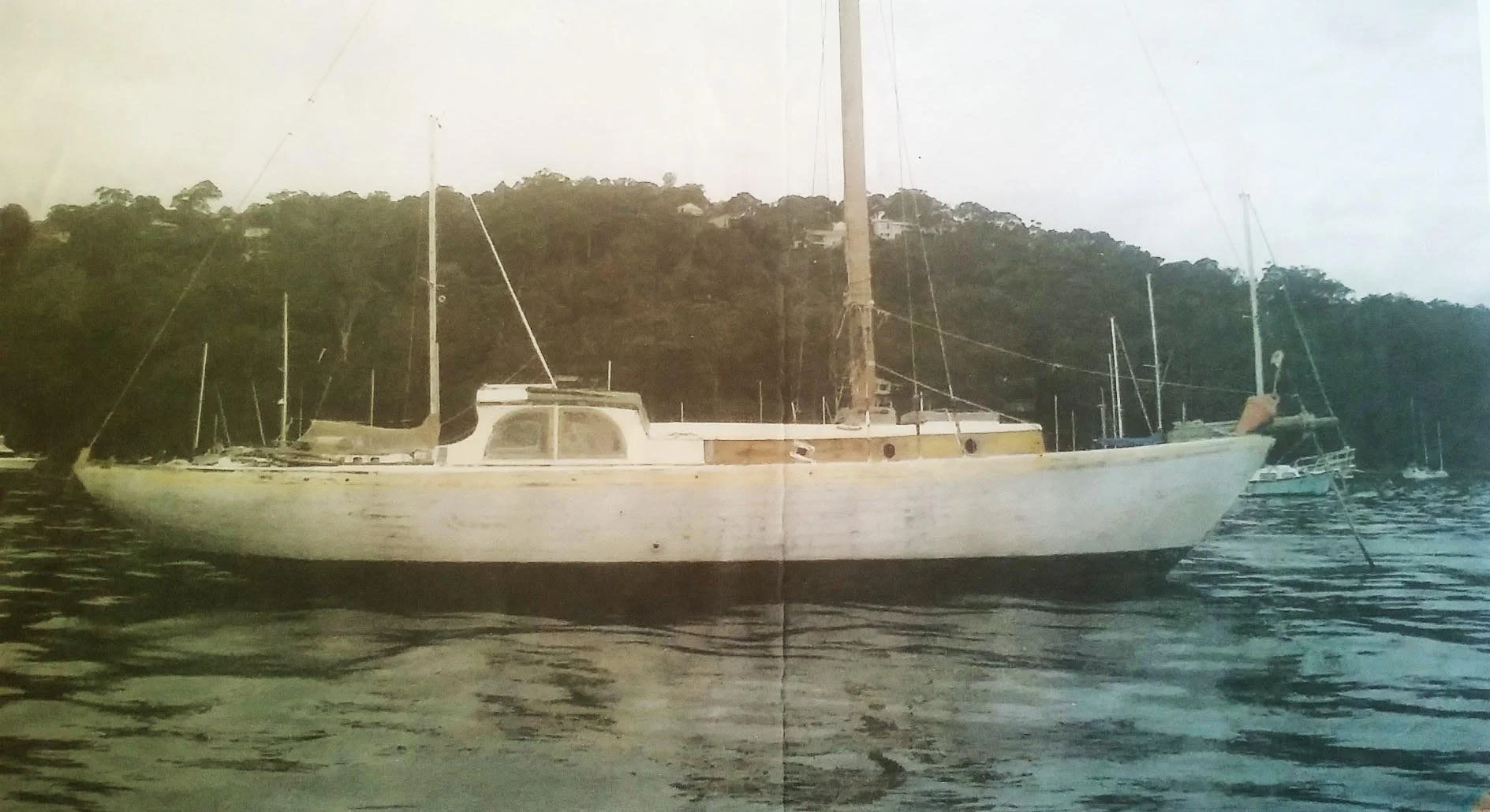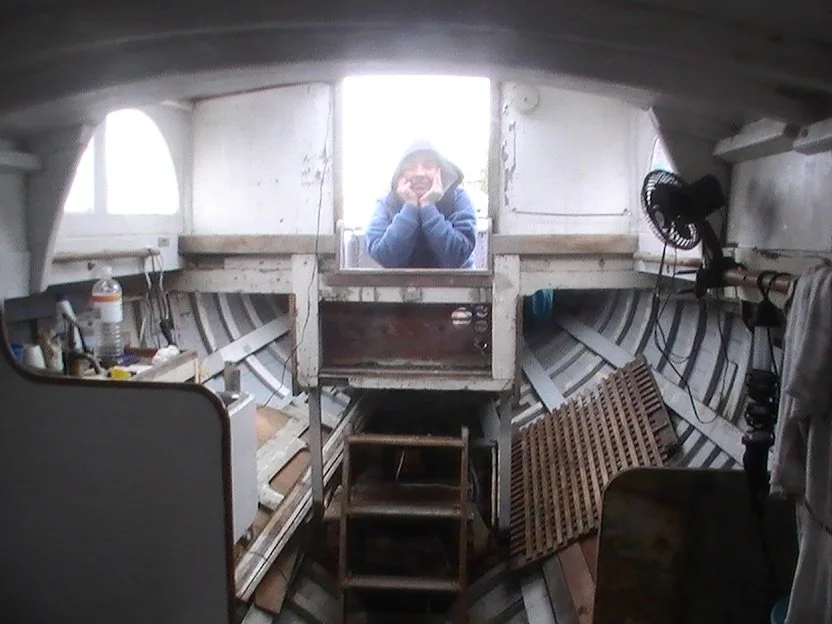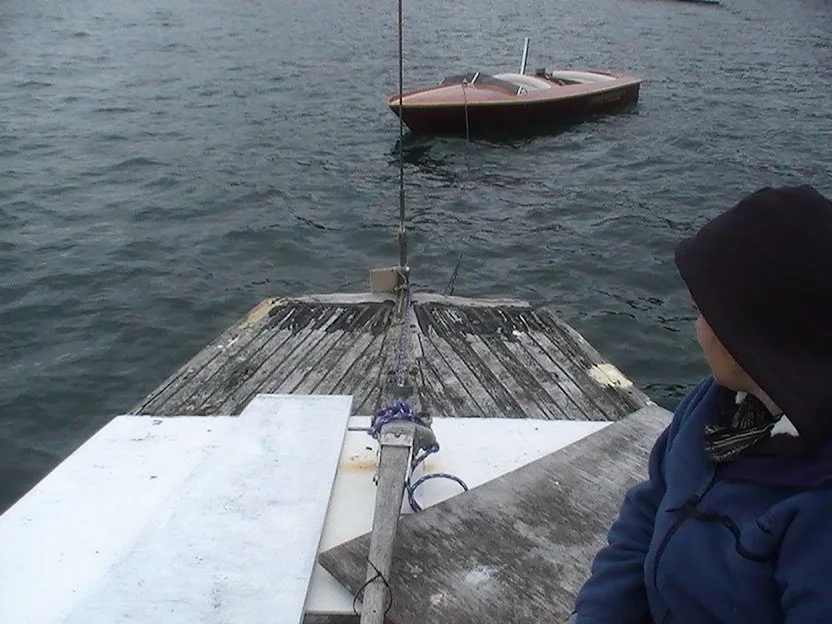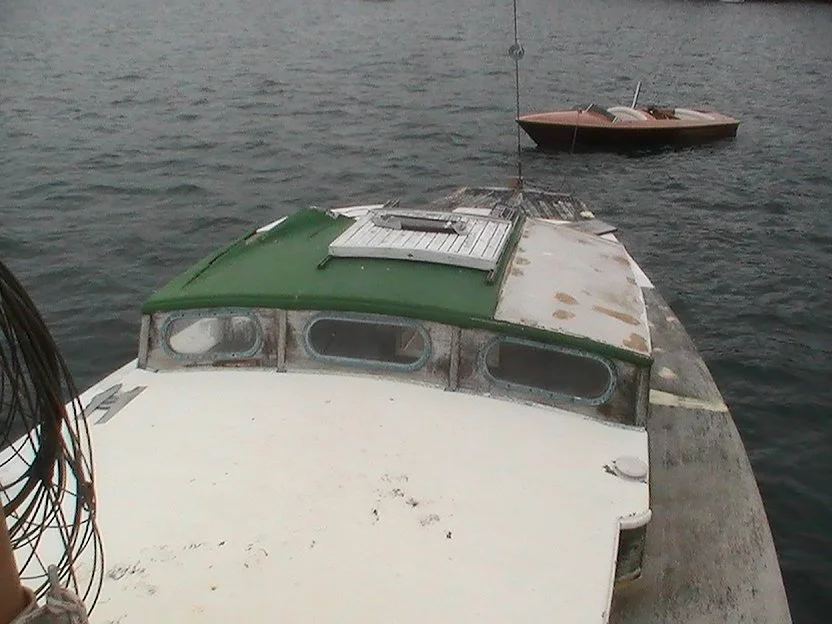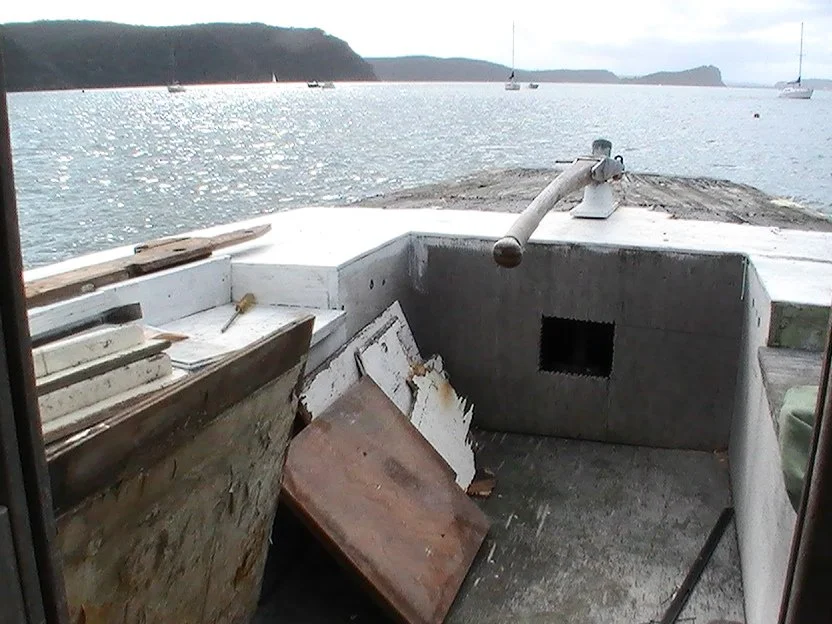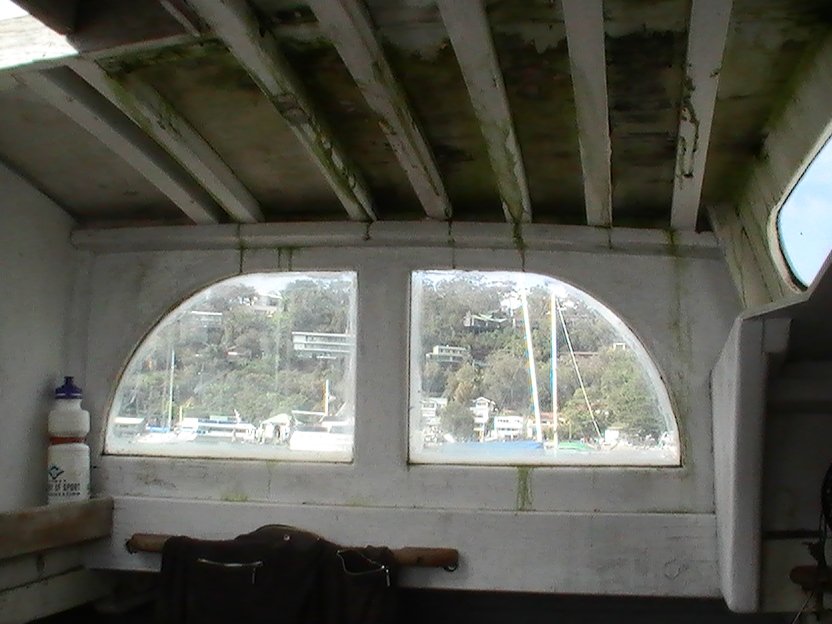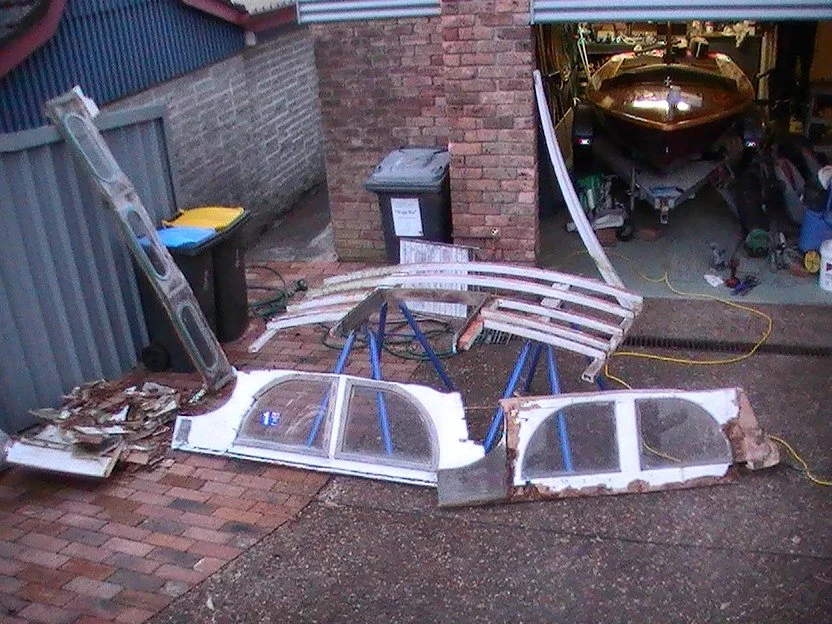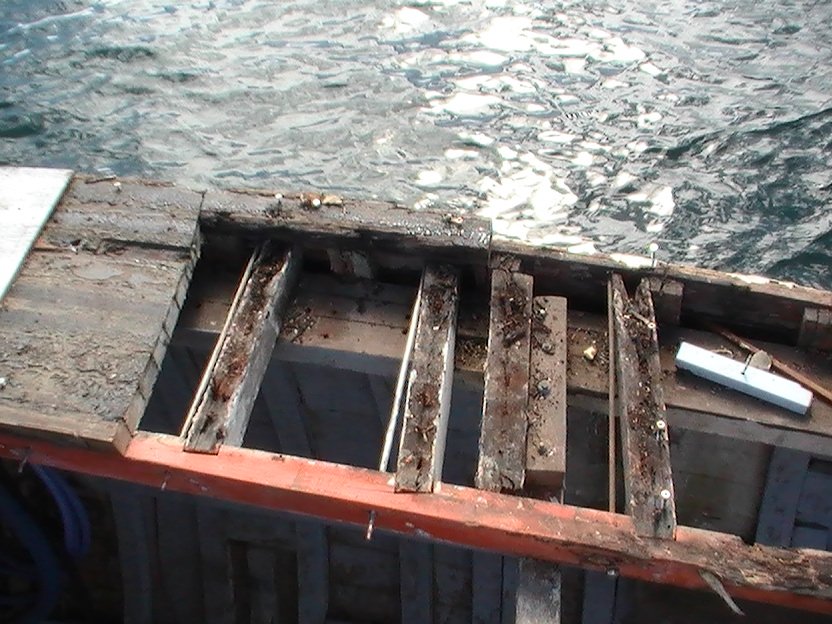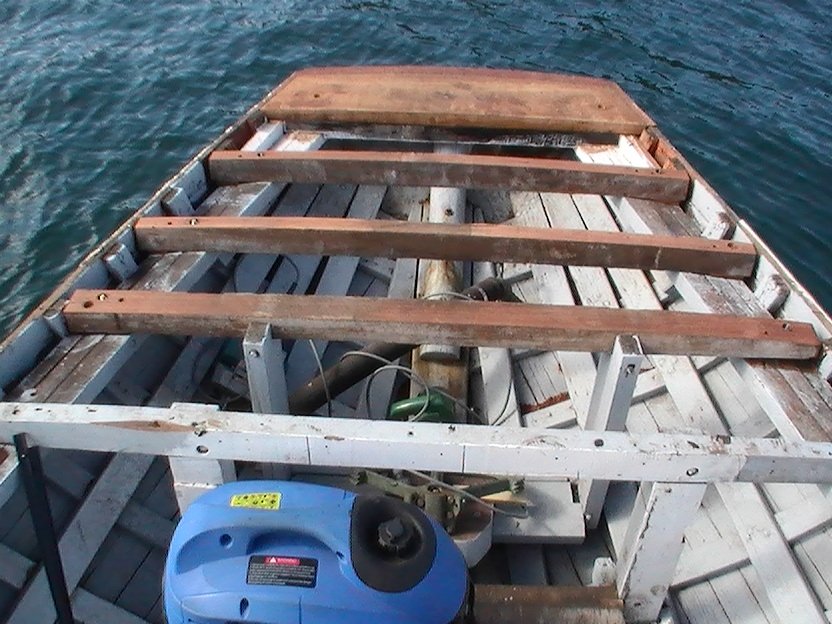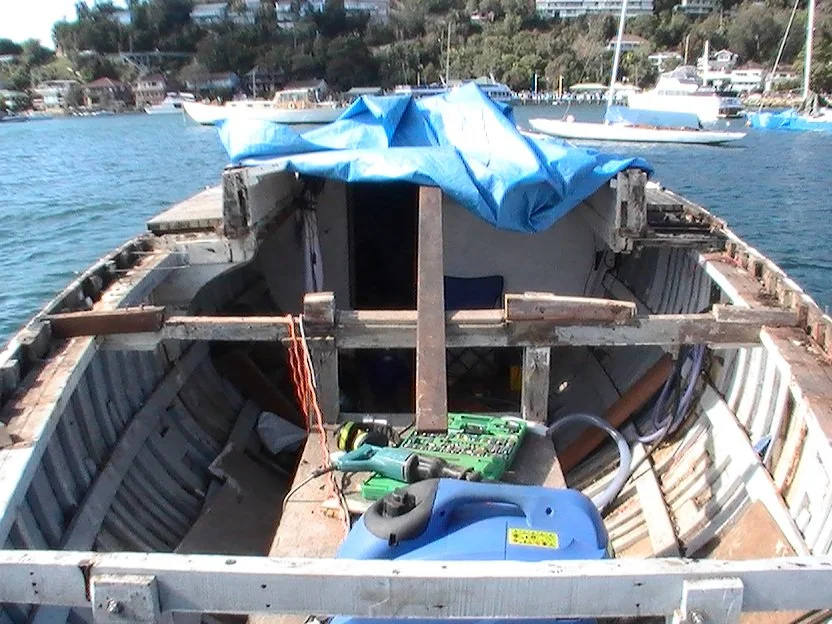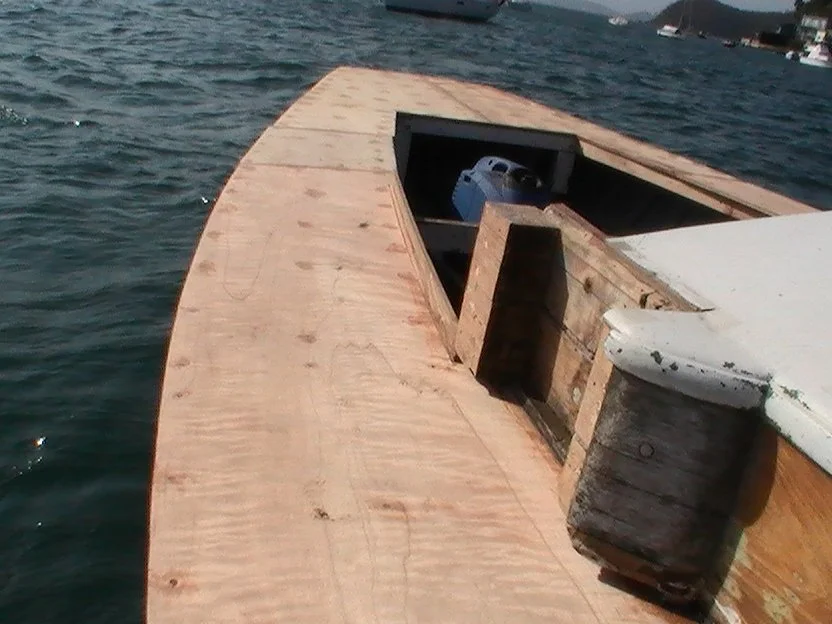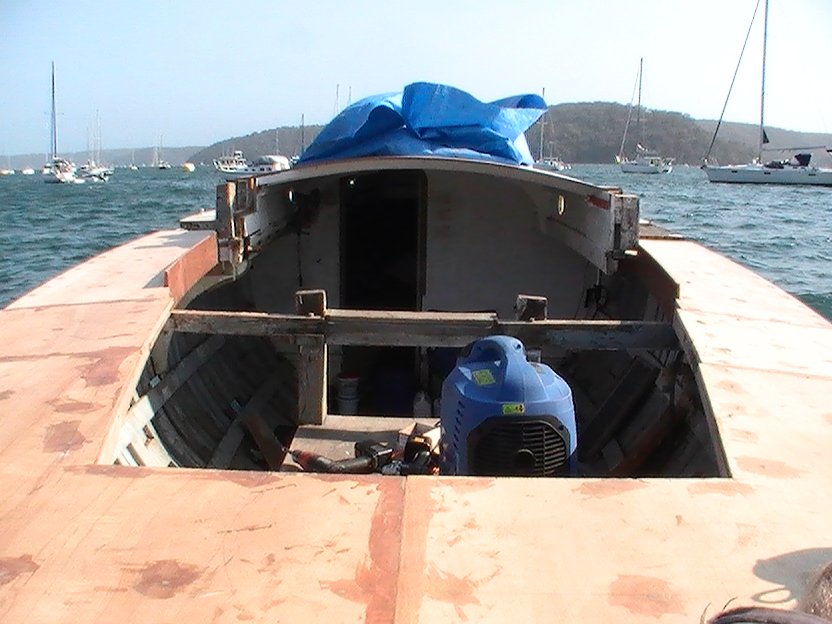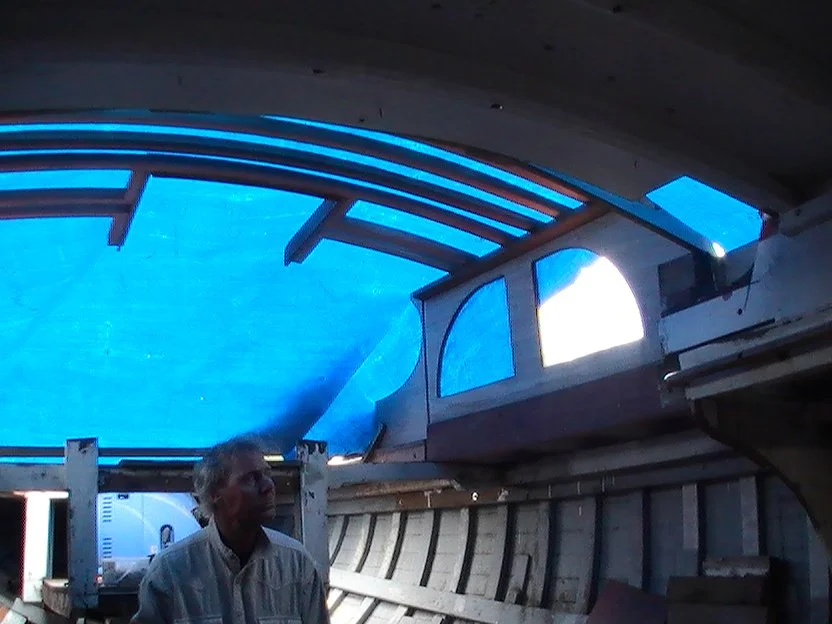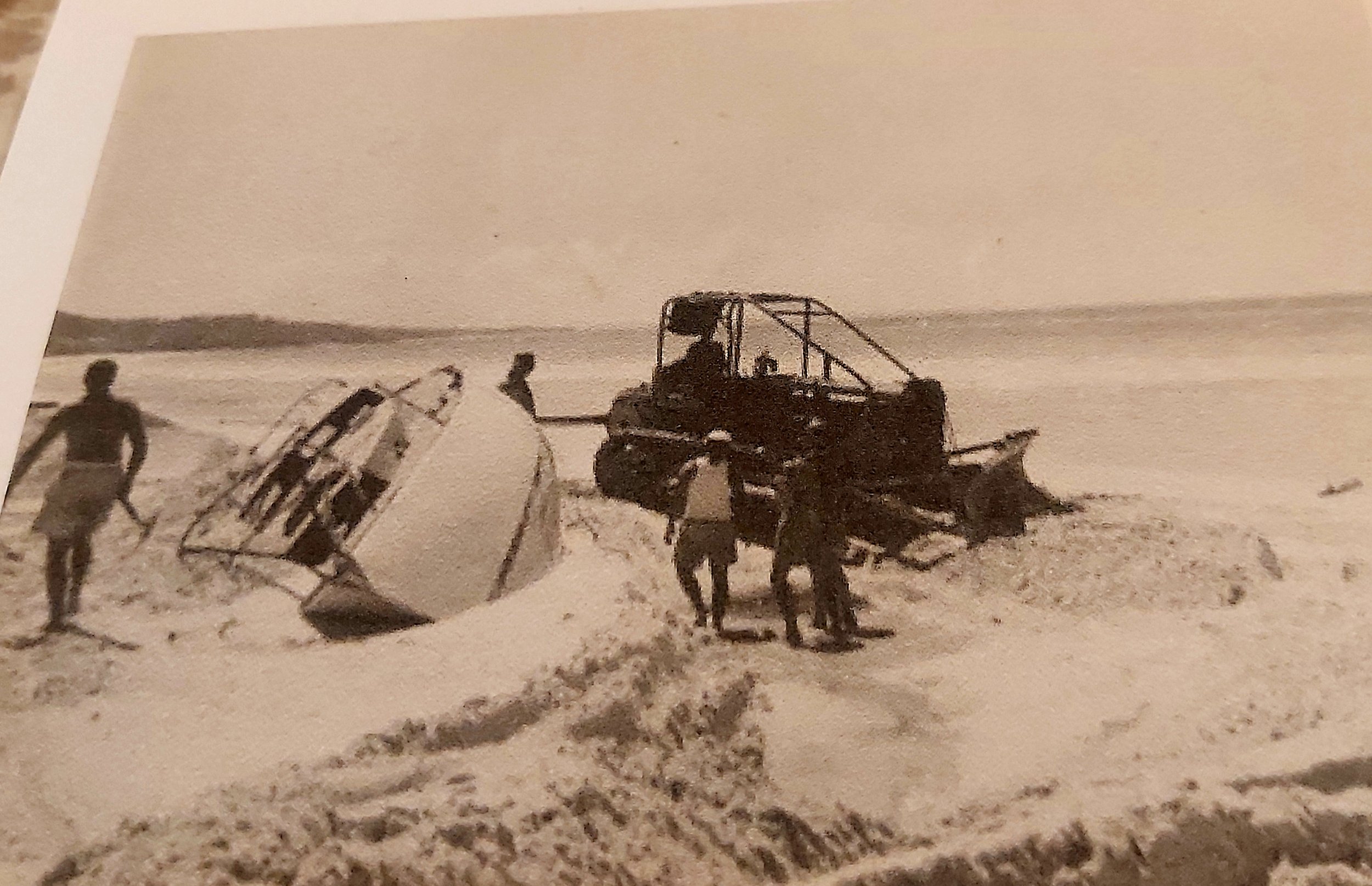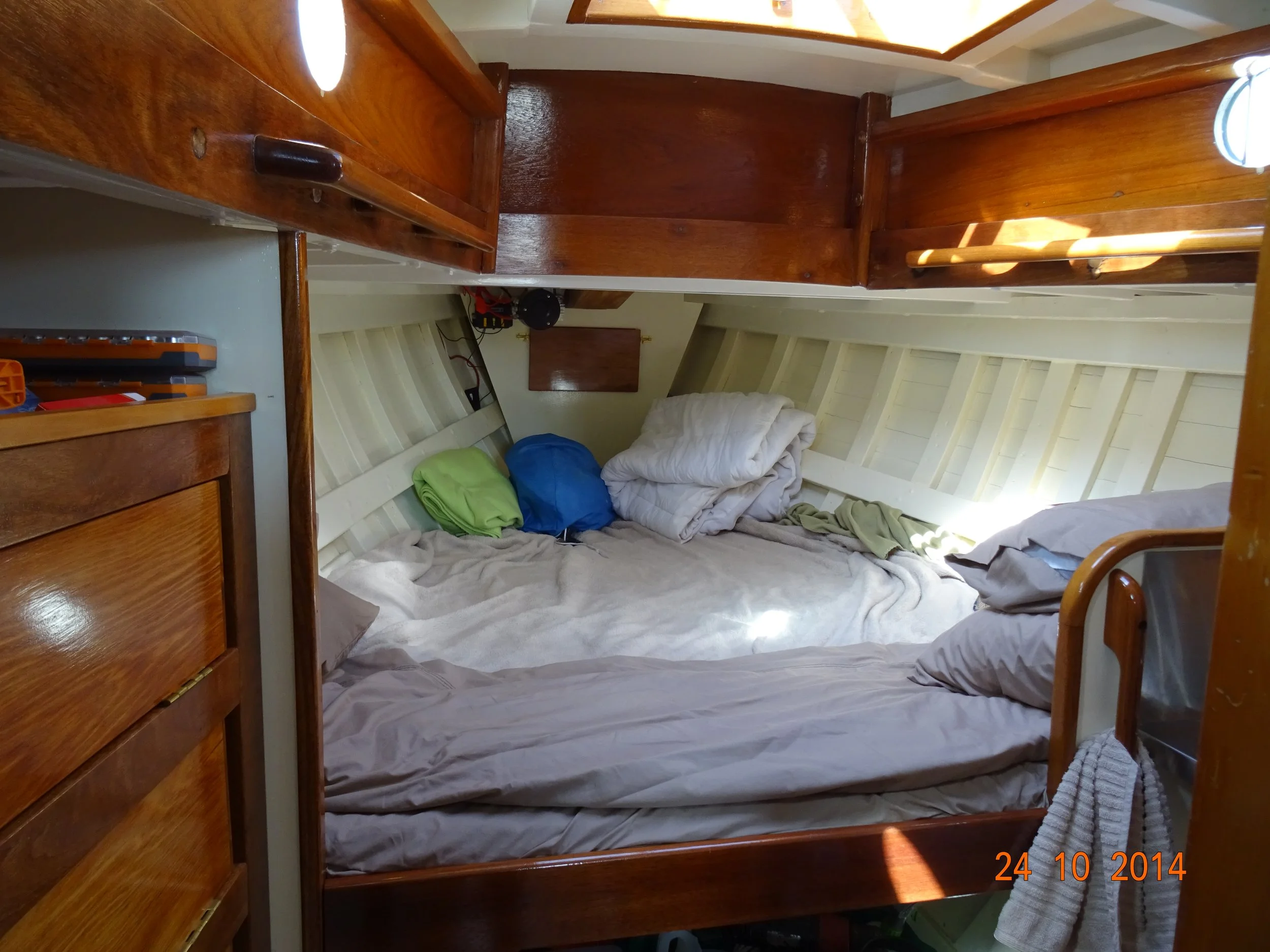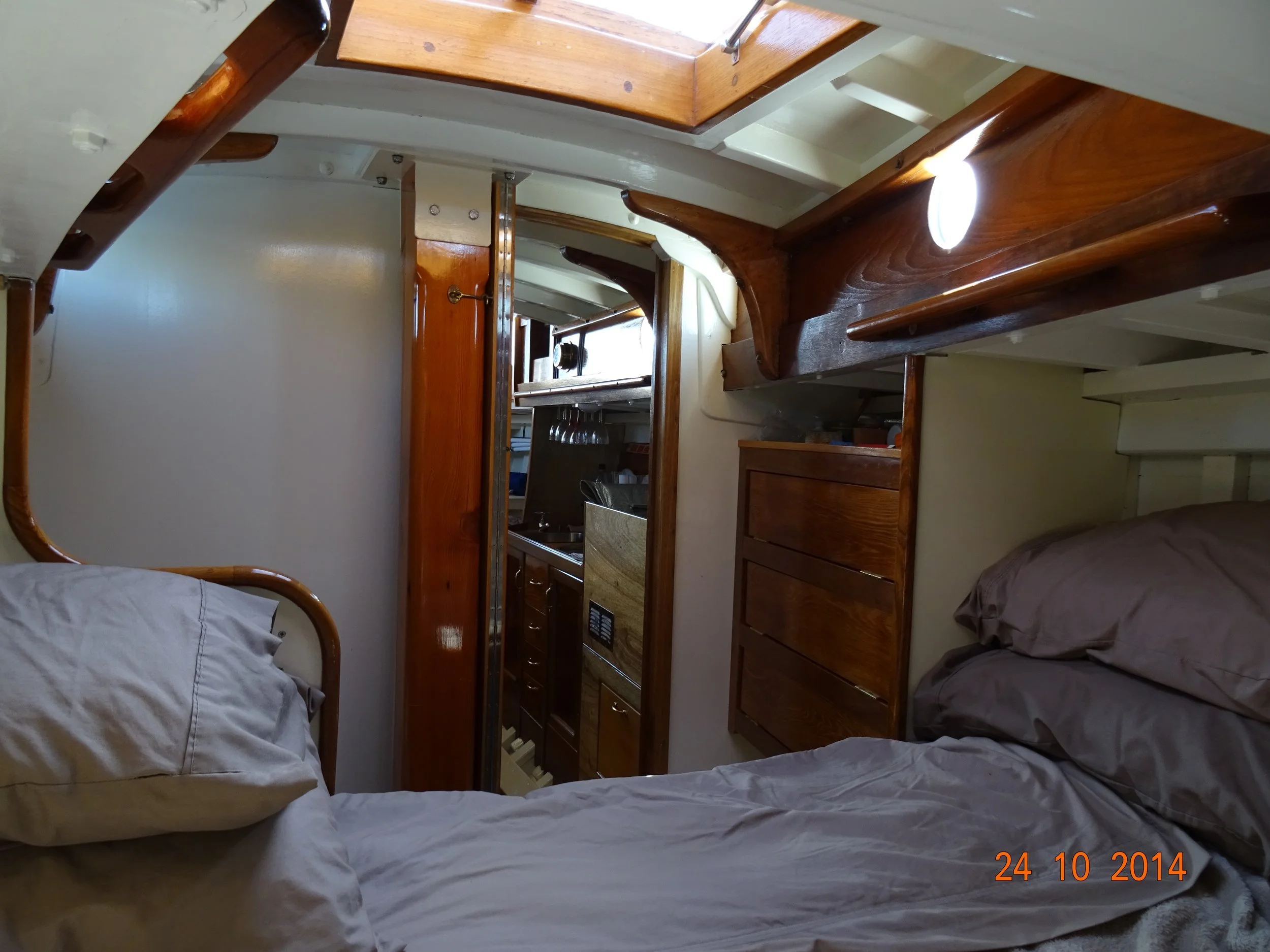Eddy Vinks and the epic restoration of BOONGOWN
By Ben Keating
It was in that moment when the wind swung that the sheer bloody cluelessness of most of us on board became apparent. Boongown - Eddy Vinks’ old, but newly and lovingly restored timber yacht from 1956 was doing what it had been designed to do. But were we?
Image-Andrea Francolini
Synonymous with hot Sydney summer days, the southerly buster had arrived with a thunder clap. Dark and roiling, its cloud bank was fast catching up with us. We were like a bunch of hapless smugglers in a row boat hopelessly trying to outrun the coast guard. Reckless. And surely soon to be wrecked.
With sails straining and fresh stainless rigging creaking under load, the strong winds shook us. Hands flew to chin straps, fastening hats to heads. Our eyes climbed the mast. What was left of the late afternoon sun, refracted off the gloss of freshly lacquered oregon. We watched the mast held aloft, steadfastly piercing the firmament, sails tightly bound to the strength and flex of the wood, while the boat below it and all of those on board tilted and groaned.
Boongown was skipping along with gusto, being pushed back up the coast towards Barrenjoey, from soon after we’d cleared North Head. We were skating the white tufted crests of a flotilla of waves. While the Sydney to Hobart fleet had headed offshore, to tack south and start their long journey towards Tasmania, we’d turned north, having waved them bon-voyage, fair winds and good sailing.
Boongown had been there and done that many years before this year's fleet had rounded South Head. For the first time, some fifty to sixty years ago and helmed by a very different crew. A handful of salty sea dogs would have been on board, a crew of experienced sailors. A crew undoubtedly a far cry from most of us, who were at best fair weather sailors and at worst pampered landlubbers quickly turning green with the chop and fury of the swell.
The shout went out from Eddy, words dragged sideways by the wind, The boom vang. Pull the boom vang down. PULL THE BOOM VANG DOWN NOW! The boat lurched. Grips tightened. Bowngown was leaning hard over. The tail of the boom was caught on the backstay and there was nothing we could do about it. 30 knots of wind. It was blowing hard.
30 knots of wind.
In hindsight, we should have had the boom vang tightly pulled down - that much is clear. For a few intense moments, we were imperilled. Sailing can bring many white knuckle moments. Moments of peak lived experience when life and death are barely separated and a watery grave seems imminently close. This may have been one of them, it does live large in our memories.
We had an experienced skipper, even if Garth was not familiar with Boongown. If she had any idiosyncrasies, he wasn’t to know of them. It was Eddy’s boat, he’d restored it, brought it back from a rotting hulk, all glinting, shiny and new. But Ed was still learning the ropes. He’d restored the boat, and just now, he was learning to sail her.
Over a tussle and a cry, the motor was started, the boat pointed into the wind, boom vang set and the crisis averted. The rest of the trip home was spent cresting the white chop, flying along at eight knots, Barrenjoey headland appearing quickly out of the afternoon haze. The trip home to Pittwater was a far cry from the leisurely cruise south to Sydney harbour that morning, dolphins surfing the bow wave as the broken sandstone cliffs and golden beaches to our right began to bake under a relentless sun.
There were many such moments in those first few years aboard Boongown. Sea legs got, sailor’s stripes hard won. It makes you wonder what sort of person takes on an epic timber yacht restoration? What are those exacting qualities to usher such a project along? All those hard days of toil that combined to bring a boat back from the dead and allowed the creation of wild days such as this one, days so solidly etched into the memories of those that experienced them.
I just had to find out.
So… I’m hanging out with an old mate. It’s a rain soaked Saturday on the northern beaches. Pittwater lies at the bottom of the hill and Boongown, the beautiful timber yacht that Eddy Vinks has restored is moored close by on a stretch of quiet water between Bayview and Church Point. I’ve known him for a lifetime. He was always going to be a carpenter. Timber was in his blood; so much so that he could well have been descended from a tree. Eddy is of Dutch descent and they’re the tallest people in Europe, so perhaps the idea is not so far-fetched as it seems. An affinity with wood has always been one of Eddy’s essential qualities, as much a part of him as his cheeky smile, and shock of blond hair.
Eddy tells the story best and it goes like this. Cradling a coffee, I lean back into the comfort of the lounge and listen as his tale unfurls.
It was August 2011. A mate of mine had bought a Beneteau yacht and invited me out on it. This day ignited the fire in me. And I just started looking around at old timber boats. For me it’s automatic - timber all the way. After all, I'm a carpenter. Why do I want a fibreglass boat?
I soon found the boat advertised at a brokerage in Clontarf. However, it was moored in Pittwater. So we jumped on a water taxi, and while we were approaching this old boat, I was admiring the shape of it, I could see its beauty. I now know that it’s a masthead sloop but back then all I could see was all that neglect and the need of some serious love.
Jumping aboard, I went over it, feeling out for all the solid timber. There were a few soft spots here and there on the inside of the coach house which I thought I could replace. It had a lot of plywood around the coach house which was delaminating. I realised - it was clear then - that the project was going to be a lot bigger than I had anticipated. But that’s always the way isn’t it?
So, we slipped it up at Palm beach, because I needed to see if the hull was any good before committing to buying it. Ian Begg who runs Mackenzie Marine is very knowledgeable about old timber boats - he’s classically trained in boat building. So we tapped around searching for woodworm and rot. We determined that the hull was sound, and the hull is the main thing, if it’s sound then we’ve got a live project - we could move forward.
The project was right there in front of me. I knew I didn’t have to look any further for a boat. If I could get it for the right money, I was sold. After a bit of haggling, I got it for less than half what they were asking. Really, they should have given it to me. It just wasn’t worth anything to anyone without deep pockets and skills.
So, I bought it and while it was on the slip, we got going with water blasting the hull and giving it some new anti-fouling. I arranged a commercial mooring off Palm Beach and off I went. For the next two and a half years I was bobbing around offshore working on it like a lunatic.
I was there pretty much every weekend and the odd day during the week. I’d wave goodbye to the family early on a Saturday morning and say see you tonight sometime. And if I condensed down all those days over two and a half years, I would have worked on it for a solid six months worth of days.
I started with stripping out everything. The whole cockpit, the coach house, I dismantled and brought it home in pieces.
The deck had been covered in plywood in an attempt to keep the boat dry - which had failed. I had to remove the whole deck and all the deck beams. I called them joists in those days because I’m a carpenter and I wasn’t up on all the maritime ship building lore and lingo. It was a massive job. And I just kept working. Boat bobbing around madly through swells and southerly gales. There was no mast. Try doing an accurate cut with a power saw while you’re being tossed side to side. But there was no way I could put it in a boat yard. It was too expensive to take it out of the water and do all the work. I had no budget for that. I’ve always done things tough. And I was getting my sea legs. I actually got seasick a few times. Seriously seasick.
At the time, various people said to me that it would be a four to five year project. I’ve never liked things dragging on. Once I commit to something, I like to get on with it and see it through. In this case, that impetus came about because I wanted the use and enjoyment out of the finished boat. And I was keen to learn to sail.
When I’d finished pulling all the rubbish material off it, it was basically just an empty hull up to the front of the coach house. Beyond that it was in pretty good shape. The original teak where the portholes are, that’s still as it was.
I spent a good two and a half weeks - at least - scraping all the old loose flakey paint from the inside of the hull. I tried to get the hull as clean as I best could. It was a helluva job. Upside down with a paint scraper in those nooks and crannies. Just murder.
During this time, paddle boarders, kayakers or other boaties would cruise past. And they’d often stop for a chat to hear about the restoration. Quite often the exchange would end with them basically telling me how mad I was for undertaking such a large project in this fashion. Among all the eye rolling, the boat would be bobbing as the tide ebbed and I’d just smile.
In the late afternoon each day, I’d take a breather, take stock of what I’d achieved. I had to be off the boat at a certain time because the tender service would come out and pick me up. You see, we’d ship all my tools and rubbish off each day via the tender boat.
I don’t think it’s that common for people to restore an old timber boat out on the water. It’s hard. That’s what slipways and boat yards are for. But I didn’t think twice about it. Not everyone would do it - it’s likely that few would but I just knuckled down and got into it. It was difficult but doable.
At this point I was not even a sailor. I’d hardly ever sailed. I knew nothing about boat building and next to nothing about sailing.
The boat hadn’t come with sails. All the rigging had to be replaced and new sails made. It was a bare hull and a mast. A 34 footer bare hull. I undertook lots of research and had lots of discussions with many people in many fields. This is some of what I learnt.
Boongown started off its life in 1956 being built adjacent to the Rock Lily in Mona Vale. The Rock Lily was an early hotel and a staging post for horse drawn coaches from Manly. But sadly the fellow who was building it couldn't finish the project, he became ill, so the hull was sold off to Doctor Jim Molesworth. Molesworth had the boat finished.
Molesworth then sailed Boongown in the Sydney to Hobart in 1958, 1959, and 1961 and entered but didn't make it all the way in the ‘64. Boongown is not a very sizable boat, it had a crew of six on those Sydney to Hobart races. Any more than four people on board and it’s uncomfortable. So six would have been a squeeze.
And while I’m not sure if it was that occasion or another, the boat was beached on the south coast. And to this day whenever the boat goes through a storm or some inclement weather that brings about flexing of the timbers, grains of sand from that beaching approximately 60 years ago fall out on the new bench tops. Residual sand is still embedded between all the timbers of the yacht. I think it had a complete refit at that stage. It had to have been on the beach for a week or longer and photos show just how deep the boat was buried in the sand.
Boongown is of an Alan Payne design and was built by the Griffin family who were based in Church Point and Mona Vale. It’s built from spotted gum which is a very hard timber. And heavy. The boat weighs 11 tons. It glides through the water like a beautiful old Jaguar. It sails so nicely because of the weight.
As a carpenter, I love my timber, I love bringing old wood back to life. For the interior fit out, I acquired timber from everywhere. It’s got 150 year old Baltic pine floor boards from a mates terrace house in Newtown that became beautiful lightweight floor panels.
The yacht didn’t come with a boom. So I made a timber one out of oregon. I laminated a few pieces of timber together and then took it to Tim Montagues' Custom Engineering to get all the fittings fabricated and attached, so that it could be mounted on the mast. Tim took one look at it and said “Mate that’s going to snap, it’s too small, it’s too thin, it’s going to snap in half like a matchstick.”
At this point as far as I was concerned, it was finished. It’d applied ten coats of varnish and it looked beautiful. So, I shrugged, and took it home and put the saw through it, cutting it in half. And then I put a lamination through the middle of it giving 35-40mm of extra timber. This was all done in my living room. So then I took it back to him and he said “Yep, that’ll do.”
We pause to make another coffee, the rain has let up outside, the light is still muted but the skies are slowly clearing towards lunchtime. Eddy hands me a cup “Strong as you like it”, he says.
The boat needed a new motor. Ian Begg gave me some very sensible advice regarding this aspect of the project. Ian said to put the biggest motor that could fit through the companionway. The motor was craned in after fabrication of a stainless steel engine mount. This was very involved, angles needing to be precise. The engine was ordered from China. A TD marine 46hp. It has never missed a beat -- it sounds like a tractor but continues to run beautifully.
Tim Montague fabricated up a stainless steel exhaust for it. Two pipes, one within the other. His brother Paul, who owns the 316 Fastening Shop in Mona Vale organised the fittings for the boom and the rest of my rigging.
Eddy pauses, his eyes crinkle and he smiles. You’ll like this one Ben, he says.
I had to move the mast at one point. So I waited until about 10pm one night and then I loaded it onto my roof racks - all twelve metres of it - the van is only six metres long, so I had three metres projecting both front and back off the van roof. And we drove it from Palm Beach, through all the Bilgola bends all the way back to Terrey Hills. With a small convoy of cars, a mate in front of me and a mate behind. Didn’t see a policeman or get into strife. Phew. It was a tense trip. I’ll never forget the relief I felt when I got it back to my home safely and without incident. Once I’d done the work on it, Paul Montague lent me a proper mast trailer to bring it back down to a barge, which then shipped it out to the yacht.
How good are mast trailers? We both grin.
We go on to talk about sailing and how Eddy has developed as a sailor. The boat has a really good handicap which has been a useful thing - Boongown and Eddy have just recently enjoyed a first place in Race Two on the Sunday of the 2022 Sydney to Hobart Veterans Regatta.
Eddy says - I think I’m becoming a fairly decent sailor but then someone else comes along who really knows their stuff and that can really put you in your place. My cousin Bob Vinks climbed aboard for the regatta and with his skills, he took Boongown from seventh place in Race One on the Saturday, to first place the following day.
Every minute, Bob was telling us which way to turn, to head up or to bear away, to zigzag with the tack and make small changes to suit the wind at that moment, to be making tiny adjustments to respond to the flow. I now want Bob as a permanent member of the crew. So Bob when you’re reading this, consider yourself warned (and invited).
Eddy enthuses that being able to take part in the annual Sydney to Hobart Veterans Regatta is exciting. He looks forward to it every year.
It’s such a lot of fun to see all those classic yachts. Beautiful old timber yachts on the water. And to be part of that, it’s fantastic. It’s very special to me.
Coming back from the regatta on Monday, I was sailing it by myself. And I was hit by some really powerful westerly winds. I was lucky to have the autopilot because I managed to reduce the sails and balance the sheets out until there was just no load on that tiller. I’ve come a long way from that early sail back with you and Garth - the day of the infamous boom vang incident.
When I was learning to sail, I cruised up and tacked down Pittwater for many months and then when I started to build confidence, I’d nudge it out the heads and head out to sea and get a feel for it. If there’s a swell running you might feel a little queasy in the guts.
Eddy is looking wistful.
He’s come a long way. He’s brought a classic timber yacht back from rotting into the water with a flawless restoration and in the years since raising the new sails for Boongown’s maiden voyage, he’s become a competent sailor.
We’re good mates, so I quietly ask Eddy what he spent on the restoration.
Around 100 grand he mumbles sheepishly. But it’s money well spent.
And then I just have to ask him - Would you do it again?
And his answer is unequivocal.
No.
But I love it, Eddy says. I’ll never sell it despite all the essential maintenance that is part and parcel of owning a timber boat; tasks like relacquering the mast every few years. You have a timber boat because you love the beauty of timber.
And I can’t agree more and I think to myself, isn't it great that we have people in the world, passionate master craftsmen like my good mate Eddy, who put all their love into a project such as Boongown, until it just seeps from every surface and inspires the admiration of everyone who sees it or is lucky enough to climb aboard.
We wrap up our conversation. It’s been a few years since I’ve last been on board Boongown and all this talk about sailing has whetted my appetite for another day out on the water. I feel that there would be nothing finer than to be under her sails, admiring her painstakingly restored timbers as we sail up Pittwater’s sheltered waters toward Barrenjoey headland and beyond that, the open sea.

